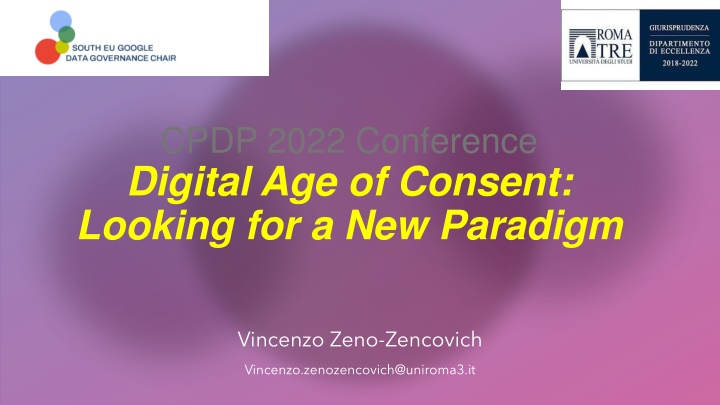
Challenges of Age of Consent in Legal Relations and Data Protection
Exploring the nuances of age of consent in legal relations and data protection, this content delves into the rights of minors, the crisis of legal capacity at coming of age, and the clash between data protection and consumer protection rules. Solutions like mandatory privacy measures are discussed to address these complex issues in contemporary Western societies.
Download Presentation

Please find below an Image/Link to download the presentation.
The content on the website is provided AS IS for your information and personal use only. It may not be sold, licensed, or shared on other websites without obtaining consent from the author. If you encounter any issues during the download, it is possible that the publisher has removed the file from their server.
You are allowed to download the files provided on this website for personal or commercial use, subject to the condition that they are used lawfully. All files are the property of their respective owners.
The content on the website is provided AS IS for your information and personal use only. It may not be sold, licensed, or shared on other websites without obtaining consent from the author.
E N D
Presentation Transcript
CPDP 2022 Conference Digital Age of Consent: Looking for a New Paradigm Vincenzo Zeno-Zencovich Vincenzo.zenozencovich@uniroma3.it
General problem of age of consent in all legal relations, both private and public Minors as subjects of fundamental rights: NY Convention on rights of children (1990) Article 12: right to express view; right to be heard Article 13: right to freedom of expression; this right shall include freedom to seek, receive and impart information and ideas of all kinds, regardless of frontiers, either orally, in writing or in print, in the form of art, or through any other media of the child's choice Article 14: freedom of thought, conscience and religion .
EU Charter Fundamental Rights Article 24: Children may express their views freely Crisis of notion of legal capacity linked to coming of age (in general, in Europe, 18 years) No one seriously challenges validity of most contractual acts by minors (e.g. child buying sweets with pocket- money): contracts for necessaries .
Structure of contemporary Western societies: Growing legally recognized autonomy of minors in self- determination on important issues (parental custody, health-care, religion etc.) At the same time protective measures in certain activities: Protection of minors in unfair contract terms Directive (2005/29) and in advertising (AudioVisual Services Directive) .
Problem in the problem: Notion of consent in provision of digital services unclear. Creation of sui generis notion of consent for data protection, completely different from contractual consent Refusal of recognizing that data are the counter- performance of most digital services Extremely difficult to enforce serious consent for adults. Impossible for minors .
Clash between data protection rules and consumer protection rules Only effective solution: further regulation Possible mandatory privacy by design measures: - No data collection by services specifically addressed to minors (what age?) - Obligation to erase all data collected after x months (what about meta-data?) .
What about favourite social media for minors? - Snapchat? - Tik-Tok - Meta? Protection of minors in digital environment Protection of minors from other minors (cyber-bullies) Use of social media in primary and middle school: control by educational institutions .
Nihil sub sole novi Age Verification The problem of age verification differs for different uses of the Internet. The District Court categorically determined that there "is no effective way to determine the identity or the age of a user who is accessing material through e-mail, mail exploders, newsgroups or chat rooms."(20) The Government offered no evidence that there was a reliable way to screen recipients and participants in such fora for age. Moreover, even if it were technologically feasible to block minors' access to newsgroups and chat rooms containing discussions of art, politics or other subjects that potentially elicit "indecent" or "patently offensive" contributions, it would not be possible to block their access to that material and "still allow them access to the remaining content, even if the overwhelming majority of that content was not indecent. [US Supreme Court ACLU v. Reno, 1997, striking 230 of the Computer Decency Act) .






















